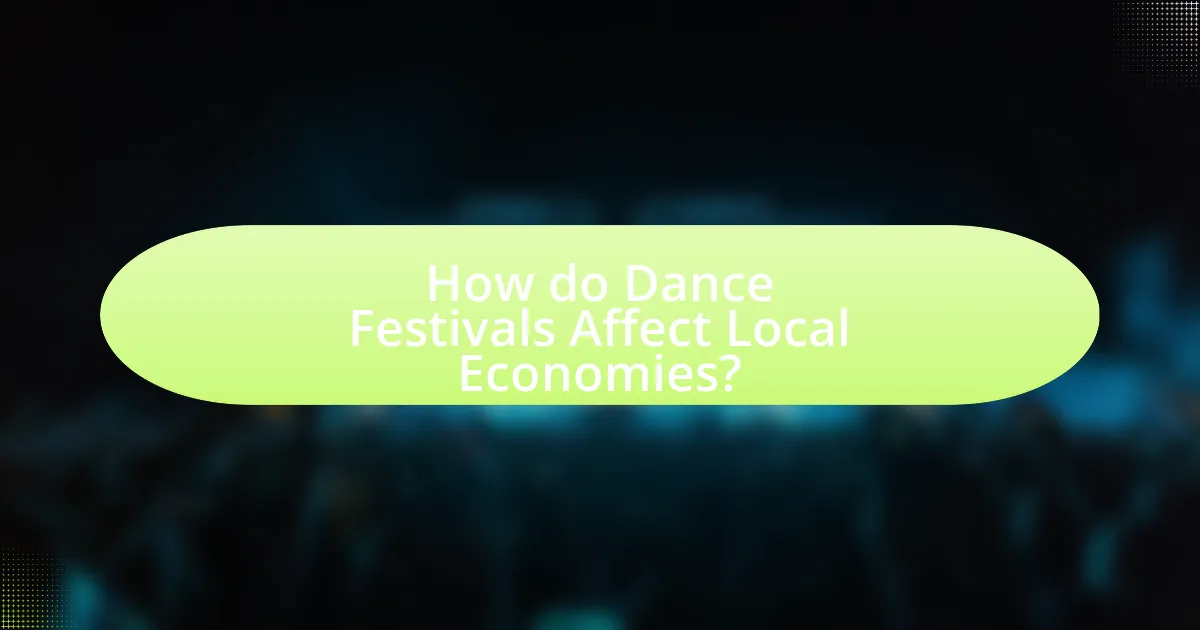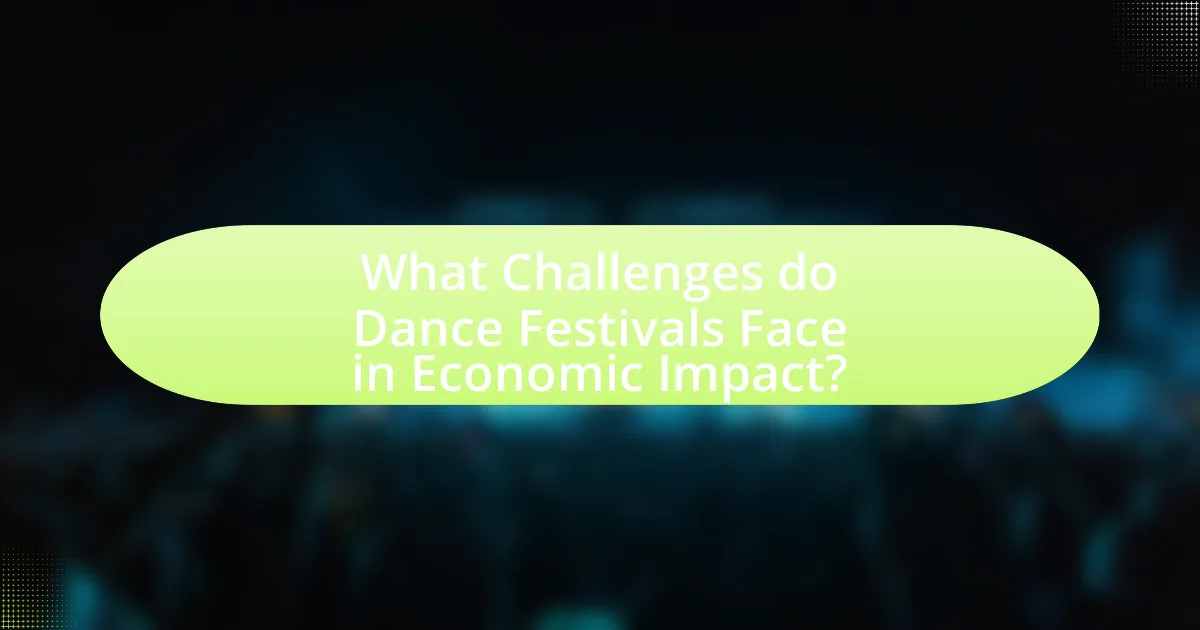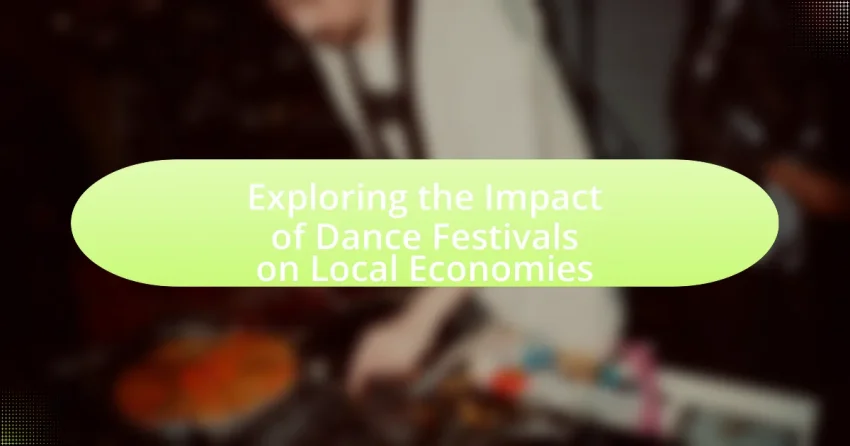Dance festivals are organized events that celebrate various dance forms, serving to promote cultural exchange, artistic expression, and community engagement. They significantly impact local economies by attracting tourists, generating revenue for businesses, and creating job opportunities. The article explores how dance festivals contribute to cultural expression, enhance community participation, and stimulate economic growth, while also addressing challenges such as funding limitations and fluctuating attendance. Key insights include the types of dance featured, the role of local communities, and strategies for ensuring sustainable economic impact through effective partnerships and community involvement.

What are Dance Festivals and Their Purpose?
Dance festivals are organized events that celebrate various forms of dance, showcasing performances, workshops, and competitions. Their primary purpose is to promote cultural exchange, artistic expression, and community engagement through dance. Additionally, dance festivals often stimulate local economies by attracting tourists, generating revenue for local businesses, and creating job opportunities in hospitality and event management. For instance, a study by the National Endowment for the Arts found that arts festivals can significantly boost local economies by increasing visitor spending and enhancing community pride.
How do Dance Festivals contribute to cultural expression?
Dance festivals contribute to cultural expression by showcasing diverse dance forms that reflect the traditions, values, and identities of various communities. These festivals serve as platforms for artists to present their cultural heritage through movement, music, and storytelling, fostering a deeper understanding and appreciation of different cultures among audiences. For instance, events like the Edinburgh Festival Fringe feature performances from around the world, highlighting unique cultural narratives and practices. This exchange not only preserves cultural traditions but also encourages dialogue and collaboration among different cultural groups, enhancing social cohesion and cultural awareness within local and global contexts.
What types of dance are typically featured in these festivals?
Dance festivals typically feature a variety of dance styles, including folk, contemporary, ballet, hip-hop, and traditional cultural dances. These styles are often showcased to celebrate cultural heritage and artistic expression, attracting diverse audiences. For instance, folk dances represent local traditions and customs, while contemporary and hip-hop reflect modern artistic trends. The inclusion of these various dance forms not only enhances the festival experience but also contributes to the local economy by drawing tourists and promoting cultural exchange.
How do local communities participate in dance festivals?
Local communities participate in dance festivals by organizing events, performing, and volunteering. These communities often collaborate with festival organizers to showcase local talent, which enhances cultural representation and fosters community pride. For instance, local dance troupes frequently perform traditional dances, attracting visitors and promoting cultural heritage. Additionally, community members may volunteer for various festival roles, such as event coordination and logistics, which strengthens community bonds and encourages local engagement. This participation not only enriches the festival experience but also contributes to the local economy by drawing tourists and generating revenue for local businesses.
What role do Dance Festivals play in community engagement?
Dance festivals play a crucial role in community engagement by fostering social interaction and cultural exchange among diverse groups. These events create opportunities for local residents to participate in artistic expression, enhancing community cohesion and pride. For instance, a study by the National Endowment for the Arts found that community-based arts events, including dance festivals, significantly increase local participation in cultural activities, leading to stronger social networks and a sense of belonging. Additionally, dance festivals often involve local artists and performers, which supports the local economy and encourages community investment in the arts.
How do festivals foster social connections among attendees?
Festivals foster social connections among attendees by creating shared experiences that encourage interaction and collaboration. These events often feature communal activities such as dancing, workshops, and performances, which facilitate bonding among participants. Research indicates that social gatherings, like festivals, enhance feelings of belonging and community, as evidenced by a study published in the Journal of Community Psychology, which found that 78% of festival-goers reported making new friends during events. Additionally, the informal atmosphere of festivals allows for spontaneous conversations and networking opportunities, further strengthening social ties among diverse groups of people.
What impact do they have on local traditions and heritage?
Dance festivals significantly enhance local traditions and heritage by promoting cultural expression and community engagement. These events often showcase traditional dance forms, which helps preserve and revitalize local customs and practices. For instance, festivals like the Edinburgh Festival Fringe have been instrumental in highlighting Scottish folk dances, thereby reinforcing cultural identity and continuity. Additionally, participation in these festivals fosters intergenerational knowledge transfer, as older generations teach younger participants traditional dances, ensuring that these practices are passed down. This dynamic not only strengthens community bonds but also attracts tourism, further embedding these traditions within the local economy and cultural landscape.

How do Dance Festivals Affect Local Economies?
Dance festivals positively impact local economies by generating significant revenue through tourism, local business engagement, and job creation. For instance, a study by the National Endowment for the Arts found that arts festivals, including dance events, can attract thousands of visitors, leading to increased spending on accommodations, food, and entertainment. In 2019, the Edinburgh Festival Fringe reported an economic impact of £140 million, demonstrating how such events can stimulate local economies. Additionally, local businesses often see a surge in sales during these festivals, further contributing to economic growth.
What economic benefits do Dance Festivals bring to local businesses?
Dance festivals provide significant economic benefits to local businesses by increasing foot traffic and consumer spending in the area. These events attract large crowds, which leads to higher sales for restaurants, hotels, retail shops, and service providers. For instance, a study conducted by the National Endowment for the Arts found that arts festivals can generate up to $1.5 million in economic impact for local communities, with a substantial portion of that revenue coming from visitor spending. Additionally, local businesses often see a boost in sales during the festival period, as attendees seek food, accommodations, and souvenirs, thereby stimulating the local economy.
How do festivals increase revenue for hotels and restaurants?
Festivals increase revenue for hotels and restaurants by attracting large numbers of visitors who require accommodations and dining options. For instance, during major dance festivals, hotels often experience a surge in bookings, with occupancy rates rising significantly, sometimes exceeding 90%. Restaurants benefit from increased foot traffic, leading to higher sales volumes, particularly in areas close to festival venues. According to a study by the National Endowment for the Arts, events like dance festivals can boost local economies by generating millions in direct spending, which directly impacts the hospitality sector. This influx of visitors creates a demand for services, resulting in increased revenue for both hotels and restaurants.
What is the impact on local artisans and vendors?
The impact on local artisans and vendors during dance festivals is significant, as these events often lead to increased sales and visibility for their products. For instance, a study conducted by the National Endowment for the Arts found that local festivals can boost artisan sales by up to 30% due to heightened foot traffic and consumer interest. Additionally, vendors benefit from the opportunity to showcase their crafts to a broader audience, fostering community engagement and cultural exchange. This economic uplift not only supports individual artisans but also contributes to the overall vitality of the local economy.
How do Dance Festivals influence tourism in local areas?
Dance festivals significantly influence tourism in local areas by attracting visitors who contribute to the local economy. These events often draw large crowds, leading to increased demand for accommodations, dining, and entertainment options. For instance, a study by the National Endowment for the Arts found that cultural events, including dance festivals, can boost local tourism revenue by up to 30%. Additionally, festivals create opportunities for local businesses to thrive, as vendors and service providers benefit from the influx of attendees. This economic stimulation can lead to job creation and enhanced community visibility, further solidifying the role of dance festivals as vital components of local tourism strategies.
What strategies do festivals use to attract tourists?
Festivals attract tourists through a combination of marketing, unique programming, and partnerships. Effective marketing strategies include targeted advertising campaigns that highlight the festival’s unique features, such as renowned artists or cultural significance, which can increase visibility and interest among potential attendees. Unique programming, such as workshops, performances, and interactive experiences, enhances the festival’s appeal, drawing in diverse audiences. Additionally, partnerships with local businesses and tourism boards can create package deals that offer discounts on accommodations and transportation, further incentivizing attendance. For example, the Edinburgh Festival Fringe employs extensive marketing and collaboration with local hotels to boost tourist numbers, contributing significantly to the local economy.
How does increased tourism affect local infrastructure?
Increased tourism significantly strains local infrastructure by elevating demand for transportation, utilities, and public services. For instance, a surge in visitors can lead to overcrowded roads and public transport systems, necessitating upgrades and expansions to accommodate the higher volume of traffic. Additionally, local utilities such as water and electricity may experience increased consumption, prompting the need for enhancements to ensure reliability. A study by the World Travel and Tourism Council indicates that tourism can contribute up to 10% of global GDP, highlighting the economic pressure on infrastructure systems in popular destinations. This increased demand often results in local governments needing to invest in infrastructure improvements to maintain service quality and support sustainable tourism growth.

What Challenges do Dance Festivals Face in Economic Impact?
Dance festivals face several challenges in achieving a positive economic impact, primarily including funding limitations, fluctuating attendance, and competition from other events. Funding limitations often hinder the ability to secure necessary resources for marketing, artist fees, and venue costs, which can lead to reduced festival quality and scope. Fluctuating attendance can result from various factors such as weather conditions, economic downturns, or competing events, making it difficult to predict revenue and manage expenses effectively. Additionally, competition from other cultural and entertainment events can dilute audience interest and sponsorship opportunities, further complicating the economic viability of dance festivals. These challenges collectively impact the potential for dance festivals to contribute significantly to local economies, as evidenced by studies showing that festivals with stable funding and consistent attendance tend to generate higher economic returns for their communities.
What are the financial risks associated with organizing a dance festival?
The financial risks associated with organizing a dance festival include high upfront costs, potential low ticket sales, and unforeseen expenses. Organizers often invest significant amounts in venue rental, artist fees, marketing, and logistics, which can lead to financial strain if ticket sales do not meet projections. For instance, a study by the National Endowment for the Arts found that many festivals fail to break even due to inadequate audience turnout, highlighting the risk of low revenue. Additionally, unexpected costs such as weather-related cancellations or increased security requirements can further exacerbate financial losses, making careful budgeting and risk assessment essential for festival organizers.
How do weather and external factors affect attendance and revenue?
Weather and external factors significantly influence attendance and revenue at dance festivals. For instance, adverse weather conditions such as rain or extreme heat can deter attendees, leading to lower ticket sales and reduced on-site spending. A study by the National Oceanic and Atmospheric Administration (NOAA) found that events held during inclement weather can see attendance drop by as much as 30%. Additionally, external factors like local economic conditions, competing events, and public transportation availability also play crucial roles; for example, festivals in economically thriving areas tend to attract more visitors, thereby increasing revenue. This correlation between favorable conditions and higher attendance is supported by data from various festival reports, indicating that optimal weather and strong local economies can enhance both participation and financial outcomes.
What challenges do organizers face in securing funding?
Organizers face several challenges in securing funding, primarily due to competition for limited resources and the need to demonstrate the economic impact of their events. Many funding sources, such as grants and sponsorships, are highly competitive, requiring organizers to present compelling proposals that highlight potential returns on investment. Additionally, organizers often struggle to quantify the direct economic benefits of dance festivals, which can make it difficult to convince potential funders of the event’s value. According to a study by the National Endowment for the Arts, arts events that can clearly articulate their economic contributions, such as job creation and tourism revenue, are more likely to secure funding.
How can Dance Festivals ensure sustainable economic impact?
Dance festivals can ensure sustainable economic impact by implementing strategies that promote local engagement, support small businesses, and attract tourism. By collaborating with local artists, vendors, and service providers, festivals can create a robust ecosystem that benefits the community economically. For instance, a study by the National Endowment for the Arts found that arts festivals can generate significant revenue for local economies, with attendees spending an average of $27 per person per day on accommodations, food, and entertainment. Additionally, festivals can establish partnerships with local hotels and restaurants to offer packages that encourage longer stays, further boosting economic activity.
What best practices can be implemented for long-term success?
To achieve long-term success in the context of dance festivals impacting local economies, organizers should implement strategic planning, community engagement, and sustainable practices. Strategic planning involves setting clear goals, budgeting effectively, and evaluating past festival performances to inform future decisions. Community engagement fosters local support and participation, which can enhance attendance and create a sense of ownership among residents. Sustainable practices, such as minimizing waste and promoting local businesses, not only benefit the environment but also strengthen the local economy by keeping resources within the community. Research indicates that festivals can generate significant economic benefits; for example, a study by the National Endowment for the Arts found that arts festivals can contribute millions to local economies through tourism and related spending.
How can festivals adapt to changing economic conditions?
Festivals can adapt to changing economic conditions by diversifying revenue streams and enhancing community engagement. By incorporating various funding sources such as sponsorships, grants, and ticket sales, festivals can mitigate financial risks associated with economic downturns. For instance, the Edinburgh Festival Fringe has successfully utilized a mix of ticket sales and sponsorships to maintain its operations during economic fluctuations. Additionally, engaging local businesses and communities can foster a supportive ecosystem, as seen in the case of the New Orleans Jazz & Heritage Festival, which collaborates with local vendors and artists to boost the local economy while ensuring festival sustainability.
What are the key takeaways for maximizing the economic impact of Dance Festivals?
To maximize the economic impact of dance festivals, organizers should focus on strategic partnerships, targeted marketing, and community engagement. Strategic partnerships with local businesses can enhance sponsorship opportunities and provide additional resources, as evidenced by the collaboration between the Edinburgh Festival Fringe and local hotels, which increased visitor stays by 20%. Targeted marketing efforts, such as utilizing social media and local influencers, can effectively reach potential attendees, demonstrated by the success of the Miami Dance Festival, which saw a 30% increase in ticket sales through social media campaigns. Lastly, engaging the local community through workshops and volunteer opportunities fosters a sense of ownership and boosts attendance, as shown by the positive feedback from participants in the San Francisco Dance Festival, where local involvement contributed to a 15% rise in local ticket sales.
